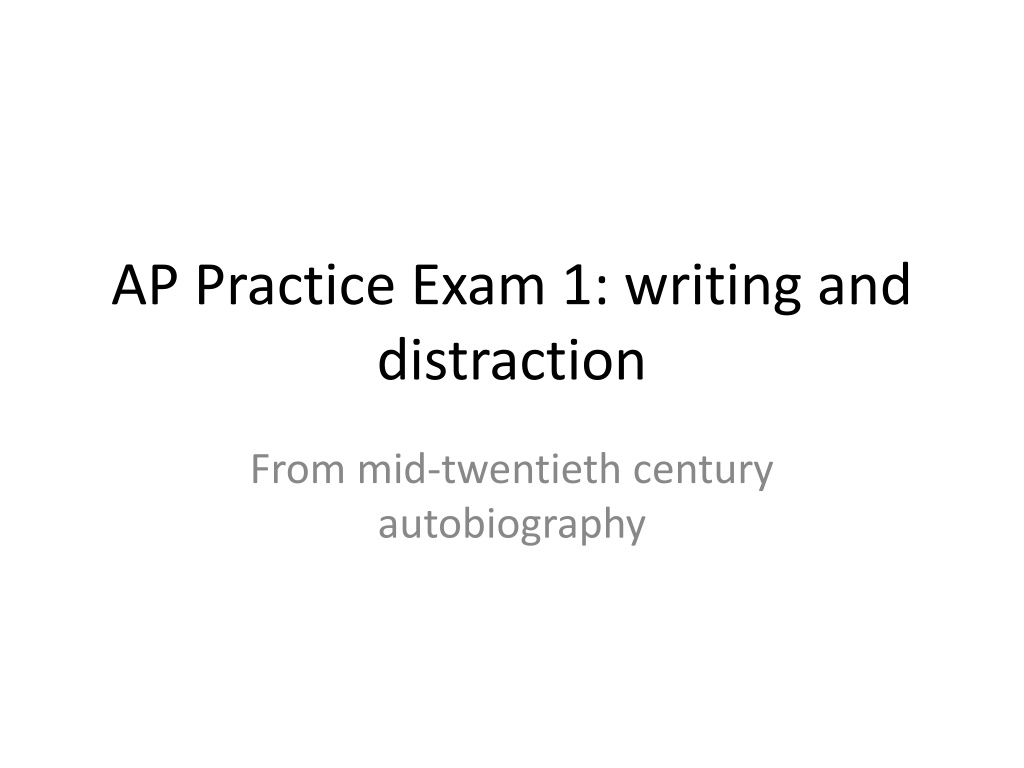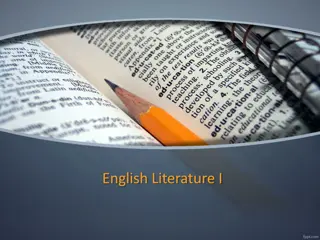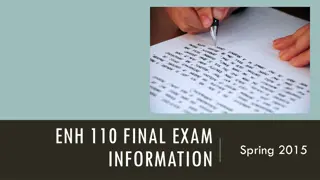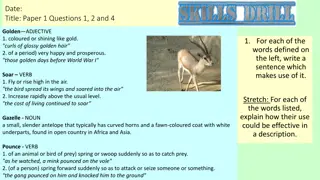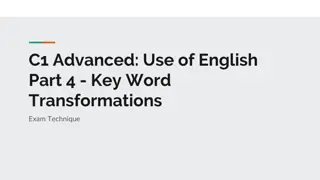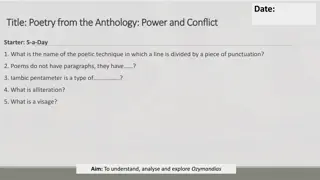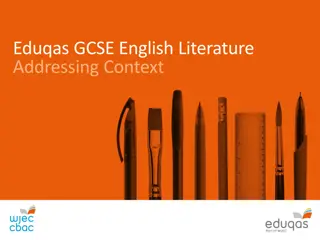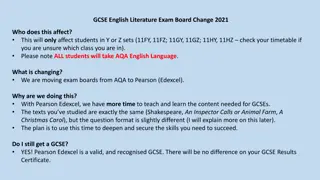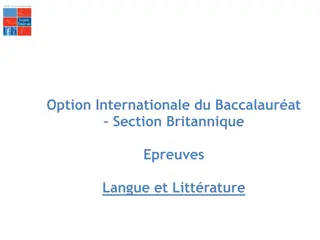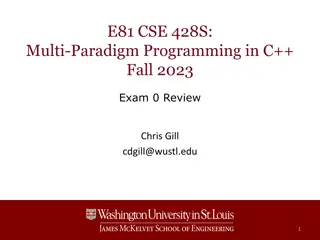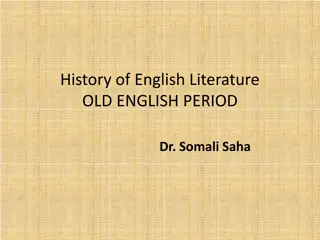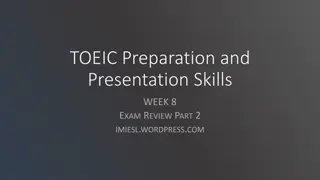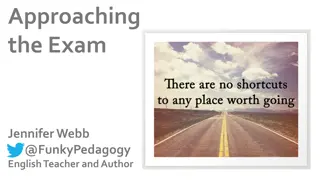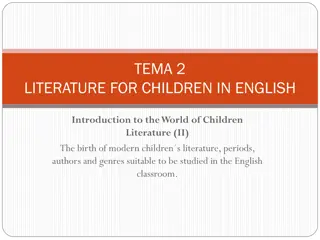Mastering AP English Literature Exam Techniques
Prepare effectively for the AP English Literature exam by understanding the question difficulty levels, overcoming obstacles faced by writers, and analyzing the relationship between speakers and characters. Practice making sophisticated inferences and recognizing rhetorical elements to excel in answering objective questions on various prose passages.
Download Presentation

Please find below an Image/Link to download the presentation.
The content on the website is provided AS IS for your information and personal use only. It may not be sold, licensed, or shared on other websites without obtaining consent from the author.If you encounter any issues during the download, it is possible that the publisher has removed the file from their server.
You are allowed to download the files provided on this website for personal or commercial use, subject to the condition that they are used lawfully. All files are the property of their respective owners.
The content on the website is provided AS IS for your information and personal use only. It may not be sold, licensed, or shared on other websites without obtaining consent from the author.
E N D
Presentation Transcript
AP Practice Exam 1: writing and distraction From mid-twentieth century autobiography
BASICS You are allotted 1 hour to answer between 45 and 60 (usually 55) objective questions on four to five prose passages. The selections may vary from works of fiction to nonfiction and from different time periods, of different styles, and of different purposes. You will be expected to: Follow sophisticated syntax Respond to diction Be comfortable with upper-level vocabulary Be familiar with rhetorical terminology Make inferences Be sensitive to irony and tone Recognize components of organization Recognize how information contained in citations contributes to the author s purpose BASICS
Remember the three levels of question difficulty: Level 1: Easiest self contained questions, like a word in context or determining the antecedent of a pronoun (the word it refers back to) LEVELS Level 2: Medium prompts you to return to a specific paragraph or line numbers for analysis or inference on things like purpose, speaker, tone Level 3: Harder asks you overall questions, like on purpose, speaker, tone
HINT: Note the underlines that reveal constant obstacles the writer has faced. Level 3
Writer PERSISTS through obstacles to continue to write. Level 3
HINT: Speaker also has an obsessionwith what? See if that helps you see the irony. Level 2
Speaker also has an obsession (and so is sympathetic), but the speaker wants QUIET, which the drunk disturbs Level 2
13.It can be inferred that the speaker and the drunk were fellow victims (line 22) in that A. Both had lost control of their passions B. Neither received support from friends or relatives C. Each had in a different way proven to be a failure D. Neither was any longer able to feel guilt or responsibility E. Both were tormented by distracting disturbances Level 2
13.It can be inferred that the speaker and the drunk were fellow victims (line 22) in that A. Both had lost control of their passions B. Neither received support from friends or relatives C. Each had in a different way proven to be a failure D. Neither was any longer able to feel guilt or responsibility E. Both were tormented by distracting disturbances HINT: The previous question may help you answer this one; what did they have in common? Think, then, about the irony between the writer and the drunk Level 2
13.It can be inferred that the speaker and the drunk were fellow victims (line 22) in that A. Both had lost control of their passions There is passion but no follow through B. Neither received support from friends or relatives No mention of this in the passage C. Each had in a different way proven to be a failure We aren t prompted to pathos that way D. Neither was any longer able to feel guilt or responsibility We know that of the writer, but not the drunk Level 2 E. Both were tormented by distracting disturbances Writer by noise, drinker by alcohol
HINT: So if the intimate source of noise gets under the skin, it is an irritation; it is a negative feeling. So look to the word choices; which ones connote positivity vs. negativity (maybe neutral)? Can that help you narrow down? Level 1
N, + +, + - +, + Level 1 N? maybe - ? Inexorably: unbending, unyielding
15. The speaker mentions Beethovens Fifth and Macbeth (lines 27-28) as examples of which of the following? A. Masterly creations flawed by insidious motifs and violent scenes B. Works of art famous for their power to annoy audiences C. Splendid artistic achievements often performed unsatisfactorily D. Artistic compositions with compelling and unforgettable elements E. Class masterpieces with which everyone should be familiar Level 2
15. The speaker mentions Beethovens Fifth and Macbeth (lines 27-28) as examples of which of the following? A. Masterly creations flawed by insidious motifs and violent scenes B. Works of art famous for their power to annoy audiences C. Splendid artistic achievements often performed unsatisfactorily D. Artistic compositions with compelling and unforgettable elements E. Class masterpieces with which everyone should be familiar Level 2 HINT: Does the writer talk about the pieces in a positive, admiring way? A negative, condescending, judgmental way?
15. The speaker mentions Beethovens Fifth and Macbeth (lines 27-28) as examples of which of the following? A. Masterly creations flawed by insidious motifs and violent scenes Underlined portion is irrelevant B. Works of art famous for their power to annoy audiences No mention of annoying audiences C. Splendid artistic achievements often performed unsatisfactorily No commentary is provided about performances D. Artistic compositions with compelling and unforgettable elements Motif and scene; they, like involved feelings are penetrating E. Class masterpieces with which everyone should be familiar No preaching about reading material is done Level 2
(28) (58) Level 2
(28) (58) Level 2
HINT: Try to match up the passage with the choices. Level 3
17 A 17 E 17 D 17 C Level 3
HINT: See underlined passage. Level 3
HINT: See underlines in passage and try to match up to the choices. Level 2
20 A: tenpenny nails, African elephant, squeaky piano pedal 20 B: buzzed, wheezed, trumpeted 20 C: whistled like tenpenny nails, buzzed like, wheezed like, trumpeted like 20 D: whistled, buzzed, wheezed Level 2
HINT: Remember question 20 in particular with the onomatopoeia, similes, concrete diction. Look, too, to the first sentence: Up on the corner lived a drunk of legend kind of like an urban fairytale! Level 3
Remember question 20 in particular with the onomatopoeia, similes, concrete diction. Look, too, to the first sentence: Up on the corner lived a drunk of legend kind of like an urban fairytale! Level 3
